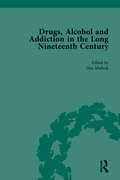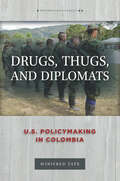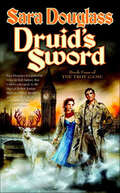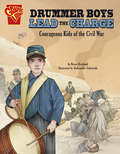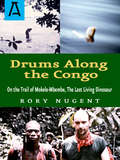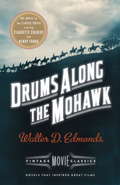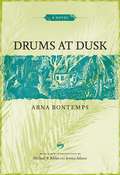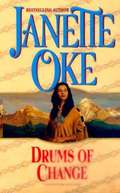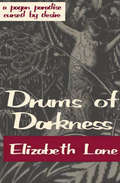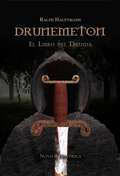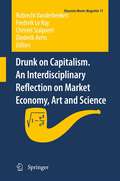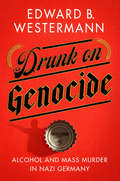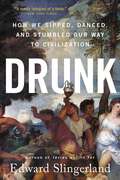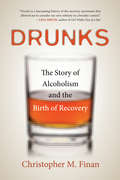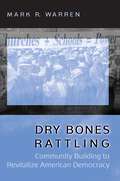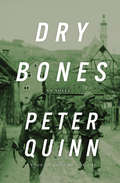- Table View
- List View
Drugs, Alcohol and Addiction in the Long Nineteenth Century: Volume III
by Dan MalleckThis collection captures key themes and issues in the broad history of addiction and vice in the Anglo-American world. Focusing on the long nineteenth-century, the volumes consider how scientific, social, and cultural experiences with drugs, alcohol, addiction, gambling, and prostitution varied around the world. What might be considered vice, or addiction could be interpreted in various ways, through various lenses, and such activities were interpreted differently depending upon the observer: the medical practitioner; the evangelical missionary; the thrill seeking bon-vivant, and the concerned government commissioner, to name but a few. For example, opium addiction in middle class households resulting from medical treatment was judged much differently than Chinese opium smoking by those in poverty or poor living conditions in North American work camps on the west coast, or on the streets of Soho. This collection will assemble key documents representing both the official and general view of these various activities, providing readers with a cross section of interpretations and a solid grounding in the material that shaped policy change, cultural interpretation, and social action.
Drugs, Alcohol and Addiction in the Long Nineteenth Century: Volume IV
by Dan MalleckThis collection captures key themes and issues in the broad history of addiction and vice in the Anglo-American world. Focusing on the long nineteenth-century, the volumes consider how scientific, social, and cultural experiences with drugs, alcohol, addiction, gambling, and prostitution varied around the world. What might be considered vice, or addiction could be interpreted in various ways, through various lenses, and such activities were interpreted differently depending upon the observer: the medical practitioner; the evangelical missionary; the thrill seeking bon-vivant, and the concerned government commissioner, to name but a few. For example, opium addiction in middle class households resulting from medical treatment was judged much differently than Chinese opium smoking by those in poverty or poor living conditions in North American work camps on the west coast, or on the streets of Soho. This collection will assemble key documents representing both the official and general view of these various activities, providing readers with a cross section of interpretations and a solid grounding in the material that shaped policy change, cultural interpretation, and social action.
Drugs, Thugs, and Diplomats: U.S. Policymaking in Colombia
by Winifred TateIn 2000, the U. S. passed a major aid package that was going to help Colombia do it all: cut drug trafficking, defeat leftist guerrillas, support peace, and build democracy. More than 80% of the assistance, however, was military aid, at a time when the Colombian security forces were linked to abusive, drug-trafficking paramilitary forces. Drugs, Thugs, and Diplomats examines the U. S. policymaking process in the design, implementation, and consequences of Plan Colombia, as the aid package came to be known. Winifred Tate explores the rhetoric and practice of foreign policy by the U. S. State Department, the Pentagon, Congress, and the U. S. military Southern Command. Tate's ethnography uncovers how policymakers' utopian visions and emotional entanglements play a profound role in their efforts to orchestrate and impose social transformation abroad. She argues that U. S. officials' zero tolerance for illegal drugs provided the ideological architecture for the subsequent militarization of domestic drug policy abroad. The U. S. also ignored Colombian state complicity with paramilitary brutality, presenting them as evidence of an absent state and the authentic expression of a frustrated middle class. For rural residents of Colombia living under paramilitary dominion, these denials circulated as a form of state terror. Tate's analysis examines how oppositional activists and the policy's targets--civilians and local state officials in southern Colombia--attempted to shape aid design and delivery, revealing the process and effects of human rights policymaking.
Druid Sacrifice
by Nigel TranterKing Arthur's niece, sister to Gawain and daughter of King Loth, the devoutly Christian Princess Thanea was born to a life of high privilege.But her fortunes took a turn for the worse when she first objected to the druidical practice of human sacrifice and then refused to marry the man her pagan father had picked out for her.Cast adrift in an oarless coracle as a sacrifice to the sea-god, Thanea managed to survive, washed up on the Fife coast and rescued by the monks of St Serf.
Druid Sacrifice
by Nigel TranterKing Arthur's niece, sister to Gawain and daughter of King Loth, the devoutly Christian Princess Thanea was born to a life of high privilege.But her fortunes took a turn for the worse when she first objected to the druidical practice of human sacrifice and then refused to marry the man her pagan father had picked out for her.Cast adrift in an oarless coracle as a sacrifice to the sea-god, Thanea managed to survive, washed up on the Fife coast and rescued by the monks of St Serf.
Druid's Sword: Book Four Of The Troy Game (The Troy Game #4)
by Sara Douglass1940. The skies above London are filled with German planes on nightly raids, a Blitz that brings a barrage of bombs that pound the city into rubble. Each morning Londoners face the night's handiwork and though they are presented with the possibility of sudden death, they are determined to fight the evil that threatens to destroy their nation. They struggle to live normal lives amid the terror and chaos. But is it only Hitler's Luftwaffe and the Blitz that is responsible for all the death and destruction that the city is facing? Brutus, the Greek Kingman who brought the bands of power to the isle of Alba millennia ago once again walks the streets of London, this time as an American major. The men and women who are his eternal companions (and sometimes lovers and enemies) have all been reborn in this time and place. They have come together for one last battle to finally complete the magical Labyrinth buried at the heart of the city. Half completed and resonating with an evil power, the Maze calls to them to complete the Game and possibly set all the players free. As Brutus works to find a solution that will end his age-old pain he comes to realize that there is a new power that walks the land. It is strong, hungry, and it has its own agenda. And by its actions could change the world forever.At the Publisher's request, this title is being sold without Digital Rights Management Software (DRM) applied.
Druids
by Morgan LlywelynHistorical fiction about Caesar's campaign in Gaul, told by a holy and revered man who was the best friend of Vercingetorix, the mighty warrior who became king of the Celts.
Druids, Gods & Heroes From Celtic Mythology (The World Mythology Series)
by Anne RossPresents a collection of myths about Fionn, Cu Chuliann, and other Celtic heroes and briefly describes the civilization that created them.
Drumbeat on the Shore
by Marjory HallFor Abigail Bates, there could be no better place to live in the whole world. She had the sand dunes and the sea for a vast front yard. Her father, Captain Simeon, was keeper of the Scituate lighthouse at Cedar Point. Their frame house overlooked the harbor. However busy she was, Nabby always had time to pause and scan the horizon for the white sails of a brig or a sloop, so peaceful against the blue that it was hard to realize they might be a threat. It was the summer of 1814, and war seemed remote in New England.... “Mr. Madison’s war,” the Federalists called it scornfully, considering that “ those dunderheads in Washington ” had invented it and that it had nothing to do with Massachusetts. But the boys and younger men in Scituate were enraged by the blockade that had closed the ports of the Delaware and Chesapeake. News from far away came slowly and was never good news. Becky, Nabby’s older sister, was wan and worried because Thomas, whom she dearly loved, was away on a secret mission that had something to do with outwitting the British and their intolerable blockade. When Peter Trumbull returns mysteriously to Scituate by night and enlists Nabby’s help, the war becomes real for her in a very personal way. It becomes real suddenly for the whole town when the British fire the ships in the harbor... when the shipyards up the North River are closed... and when the militia are stationed at the lighthouse... This is the exciting story of Nabby Bates and her sister Becky--two girls whose heroism in the War of 1812 is part of American legend. Marjory Hall has brought them to vivid life in this excellent historical re-creation of Massachusetts’ part in the “ war at sea ” with the British. It is also a warm and lively account of the independent Bates family, every one of them an active and interesting person, and of their life at the foot of a famous American lighthouse during an important period in our country’s past.
Drummer Boys Lead the Charge: Courageous Kids of the Civil War (Courageous Kids)
by Bruce BerglundIn the early 1860s, the United States is torn apart by Civil War. The conflict between the North and the South affects everyone, including many boys who want to join in the fight. Among them are young Edward Black, Lyston and Orion Howe, and Charles Moore. They're too young to fight in combat, but they show their courage by marching to battle as drummer boys. Like any other soldiers in the war, they risk being wounded, captured, or killed in action. But in spite of the risk, these courageous boys bravely face the dangers of war to help fight for their country.
Drums Along the Congo: On the Trail of Mokele-Mbembe, the Last Living Dinosaur
by Rory NugentIn the heart of the Congo is rumored to live a dinosaur called Mokele-Mbembe, or the god-beast. A handful of scientific expeditions have searched for it over the years with little success, but Nugent, traveling by himself, relied less on science than a desire to document the obscure. After a ritual exorcism in Brazzaville, he made his way by dugout canoe and foot to Lake Tele, reputed home of the bronto-like creature. It's an environment little changed since the age of dinosaurs and he spent weeks paddling and trekking the area. He finally spotted a periscope-shaped object (think of an elegant French Curve) moving through the water. But when he tried to get closer, his guides threatened to shoot him, explaining that the "the god can approach man, but man never approaches the god." His photographs have been reprinted hundreds of times by those who perceive the god-beast. The book merited inclusion on "Best 50 Books of the Year" list compiled by every major US newspaper.
Drums Along the Congo: On the Trail of Mokele-Mbembe, the Last Living Dinosur
by Rory NugentIn the heart of the Congo is rumored to live a dinosaur called Mokele-Mbembe, or the god-beast. A handful of scientific expeditions have searched for it over the years with little success, but Nugent relied less on science than a desire to document the obscure. He made his way by dugout canoe and foot to Lake Tele, reputed home of the brontosaurus-like creature. It's an environment little changed since the age of dinosaurs and he spent weeks paddling and trekking the area. He finally spotted a periscope-shaped object moving through the water. But when he tried to get closer, his guides threatened to shoot him, explaining that the "the god can approach man, but man never approaches the god." Nugent's photographs have been reprinted hundreds of times by those who believe in the god-beast. Drums Along the Congo merited inclusion on "Best 50 Books of the Year" list compiled by every major US newspaper.
Drums Along the Mohawk
by Walter D. EdmondsThe bestselling novel behind John Ford's acclaimed film starring Claudette Colbert, Henry Fonda, and Edna May Oliver. When newlyweds Gilbert and Lana Martin settle in the Mohawk Valley in 1776, they work tirelessly against the elements to build a new life. But even as they clear land and till soil to establish their farm, the shots of the Revolutionary War become a rallying cry for both the loyalists and the patriots. Soon, Gil and Lana see their neighbors choose sides against each other--as British and Iroquois forces storm the valley, targeting anyone who supports the revolution. Originally published in 1936, this classic novel was a bestseller for two years--second only to Gone with the Wind--and was adapted into a motion picture in 1939. Now, some three-quarters of a century later, Drums Along the Mohawk stands as a brilliant account of the majesty of the New York frontier, the timeless rhythms that shape a marriage, and the battles of a revolution that would change the world. Foreword by Diana GabaldonVintage Movie Classics spotlights classic films that have stood the test of time, now rediscovered through the publication of the novels on which they were based.From the Trade Paperback edition.
Drums At Dusk
by Arna Bontemps Michael P. Bibler Jessica AdamsA story of love, violence, and race set at the outbreak of the Haitian Revolution in 1791, African American writer Arna Bontemps's Drums at Dusk immerses readers in the opulent and brutal -- yet also very fragile -- society of France's richest colony, Saint Domingue. First published in 1939, this novel explores the complex web of tensions connecting wealthy plantation owners, poor whites, free people of color, and the slaves who stunned the colony and the globe by uniting in a carefully planned uprising. The novel's hero, Diron Desautels, a white Creole born in Saint Domingue who belongs to the French antislavery group Société des Amis des Noirs, attempts to spread his message of "liberty, equality, fraternity" in a world fraught with conflict.
Drums of Autumn: (outlander 4) (Outlander #4)
by Diana GabaldonThe magnificent saga continues. . . . It began in Scotland, at an ancient stone circle. There, a doorway, open to a select few, leads into the past--or the grave. Claire Randall survived the extraordinary passage, not once but twice. Her first trip swept her into the arms of Jamie Fraser, an eighteenth-century Scot whose love for her became legend--a tale of tragic passion that ended with her return to the present to bear his child. Her second journey, two decades later, brought them together again in frontier America. But Claire had left someone behind in the twentieth century. Their daughter, Brianna. . . . Now Brianna has made a disturbing discovery that sends her to the stone circle and a terrifying leap into the unknown. In search of her mother and the father she has never met, she is risking her own future to try to change history. . . and to save their lives. But as Brianna plunges into an uncharted wilderness, a heartbreaking encounter may strand her forever in the past. . . or root her in the place she should be, where her heart and soul belong. . . .
Drums of Change (Women of the West #12)
by Janette OkeRunning Fawn loved her place of birth, the site of the Blackfoot tribe's winter camp, more than words could express. The stillness of the mountain, the giant spruce and pine that covered the hillsides, and the gurgle of the spring that squeezed its crystal water from the rock crevice-she couldn't even imagine a different kind of life. This was her home. But the coming of white men with their guns and diseases, the prairie fires that swept the grazing lands, and the quick slaughter of the buffalo herds leave her Blackfoot tribe with little choice but to take up residence on the assigned Reserve. All too soon the world that Running Fawn has cherished is left behind.
Drums of Darkness
by Elizabeth LaneThe beat of passion lures a widow into the arms of two brothers in this suspenseful romantic thriller set in the exotic jungles of nineteenth-century Panama. Claire Sagan had originally come to the wild lushness of Panama to join her husband. Now she is there and her husband is dead, his name disgraced. In a search to clear his good name, Claire finds herself among the wealthy yet wildly eccentric Jarnacs. Panama is a land of strange fauna and flora, of voodoo and plantations, a nexus of energy where two oceans and two continents collide. It is where the two Jarnac brothers, hot-blooded Andre and scheming Philippe, converge over the love of Claire. In this tropical, mystical Eden, nothing is simple—certainly not love, certainly not the bloody murders of several servants. The only one with answers might be the beautiful and mad Angelique. But how will Claire get the truth from this fair-haired jungle witch when it might be Angelique herself behind all the rhythmic midnight meetings and devilish debauchery? Claire need only follow the drums to find the truth in a jungle throbbing and pulsating with treachery and deceit.
Drunemeton: El Libro del Druida
by Ralph HauptmannLa vida de Aleso da un vuelco cuando, sin pretenderlo, se ve involucrado en una conspiración en la que está implicado su padre, un caudillo de la tribu tectosaga del sur de la Galia. El fracaso de la sublevación es el inicio de una odisea para el joven de apenas diecisiete años que le lleva a una larga travesía por el mundo conocido de la Antigüedad en busca del cumplimiento de su destino que le fue profetizado durante su iniciación como guerrero. Sin embargo, en su incesante viaje por Macedonia, Grecia, Tracia y Asia Menor, Aleso no está solo. Le sigue en secreto Erbolg, un miembro de la misteriosa hermandad de Dru Vid, que llegó desde la isla occidental de Ierne unos años atrás, supuestamente para llevar su gran conocimiento de la Naturaleza y de los dioses a las tribus del pueblo guerrero, los galos. Solo los propios Dru Vid saben que su verdadera misión es muy diferente... La historia de los gálatas de Asia Menor como una apasionante novela, investigada históricamente hasta el más mínimo detalle e ilustrada con mapas, fotos y dibujos del autor, del autor del exitoso libro de no ficción "Herrscher der Eisenzeit". Die Kelten - Auf den Spuren einer geheimnisvollen Kultur" (Wilhelm Heyne Verlag 2012) (Soberanos de la Edad de Hierro. Los Celtas: tras los rastros de una cultura misteriosa, Ed. Wilhelm Heyne, 2012).
Drunk on Capitalism. An Interdisciplinary Reflection on Market Economy, Art and Science
by Christel Stalpaert Frederik Le Roy Robrecht Vanderbeeken Diederik AertsThe book presents an interdisciplinary collection of analyses that discuss the impact of market economy on our culture in the post-Berlin Wall era. It contains two parts. The first focuses on the commercialisation of science and education. The second elaborates on the multiple and diverse relation between art and capital.
Drunk on Genocide: Alcohol and Mass Murder in Nazi Germany (Battlegrounds: Cornell Studies in Military History)
by Edward B. WestermannIn Drunk on Genocide, Edward B. Westermann reveals how, over the course of the Third Reich, scenes involving alcohol consumption and revelry among the SS and police became a routine part of rituals of humiliation in the camps, ghettos, and killing fields of Eastern Europe. Westermann draws on a vast range of newly unearthed material to explore how alcohol consumption served as a literal and metaphorical lubricant for mass murder. It facilitated "performative masculinity," expressly linked to physical or sexual violence. Such inebriated exhibitions extended from meetings of top Nazi officials to the rank and file, celebrating at the grave sites of their victims. Westermann argues that, contrary to the common misconception of the SS and police as stone-cold killers, they were, in fact, intoxicated with the act of murder itself. Drunk on Genocide highlights the intersections of masculinity, drinking ritual, sexual violence, and mass murder to expose the role of alcohol and celebratory ritual in the Nazi genocide of European Jews. Its surprising and disturbing findings offer a new perspective on the mindset, motivation, and mentality of killers as they prepared for, and participated in, mass extermination.Published in Association with the US Holocaust Memorial Museum.
Drunk: How We Sipped, Danced, and Stumbled Our Way to Civilization
by Edward SlingerlandA "entertaining and enlightening" deep dive into the alcohol-soaked origins of civilization—and the evolutionary roots of humanity&’s appetite for intoxication. (Daniel E. Lieberman, author of Exercised) While plenty of entertaining books have been written about the history of alcohol and other intoxicants, none have offered a comprehensive, convincing answer to the basic question of why humans want to get high in the first place. Drunk elegantly cuts through the tangle of urban legends and anecdotal impressions that surround our notions of intoxication to provide the first rigorous, scientifically-grounded explanation for our love of alcohol. Drawing on evidence from archaeology, history, cognitive neuroscience, psychopharmacology, social psychology, literature, and genetics, Slingerland shows that our taste for chemical intoxicants is not an evolutionary mistake, as we are so often told. In fact, intoxication helps solve a number of distinctively human challenges: enhancing creativity, alleviating stress, building trust, and pulling off the miracle of getting fiercely tribal primates to cooperate with strangers. Our desire to get drunk, along with the individual and social benefits provided by drunkenness, played a crucial role in sparking the rise of the first large-scale societies. We would not have civilization without intoxication. From marauding Vikings and bacchanalian orgies to sex-starved fruit flies, blind cave fish, and problem-solving crows, Drunk is packed with fascinating case studies and engaging science, as well as practical takeaways for individuals and communities. The result is a captivating and long overdue investigation into humanity's oldest indulgence—one that explains not only why we want to get drunk, but also how it might actually be good for us to tie one on now and then.
Drunks: An American History
by Christopher M. FinanA social history of alcoholism in the United States, from the seventeenth century to the present dayToday, millions of Americans are struggling with alcoholism, but millions are also in long-term recovery from addiction. Alcoholics Anonymous and a growing number of recovery organizations are providing support for alcoholics who will face the danger of relapse for the rest of their lives. We have finally come to understand that alcoholism is a treatable illness. But in the beginning, our nation condemned drunks for moral weakness. President John Adams renounced his alcoholic son, Charles, and refused to bury him in the family crypt.Christopher Finan reveals the history of our struggle with alcoholism and the emergence of a search for sobriety that began among Native Americans in the colonial period. He introduces us to the first of a colorful cast of characters, a remarkable Iroquois leader named Handsome Lake, a drunk who stopped drinking and dedicated his life to helping his people achieve sobriety. In the early nineteenth century, the idealistic and energetic “Washingtonians,” a group of reformed alcoholics, led the first national movement to save men like themselves. After the Civil War, doctors began to recognize that chronic drunkenness is an illness, and Dr. Leslie Keeley invented a “gold cure” that was dispensed at more than a hundred clinics around the country. But most Americans rejected a scientific explanation of alcoholism. A century after the ignominious death of Charles Adams came Carrie Nation. The wife of a drunk, she destroyed bars with a hatchet in her fury over what alcohol had done to her family. Prohibition became the law of the land, but nothing could stop the drinking.Finan also tells the dramatic story of Bill Wilson and Dr. Bob Smith, who helped each other stay sober and then created AA, which survived its tumultuous early years and finally proved that alcoholics could stay sober for a lifetime. This is narrative history at its best: entertaining and authoritative, an important portrait of one of America’s great liberation movements.
Dry Bones (The Fintan Dunne Trilogy)
by Peter QuinnDry Bones, the third novel of the Fintan Dunne series by Peter Quinn, follows Fintan, who works for the OSS, the forerunner of the Central Intelligence Agency (CIA). The novel is set during World War II, when Fintan teams up with several of his colleagues working to rescue several intelligence officers who had been fighting the Nazis inside Czechoslovakia. Things go awry and the team soon uncovers a huge conspiracy that may change the course of their careers and their lives. After the end of the war, many of his colleagues have bad things happen to them. The common thing about his friends who either go missing or end up dead is that they were trying to unearth the mystery of an infamous doctor who had gone missing. It seems the CIA is determined to ensure that what happened to the infamous doctor who had made his name experimenting on prisoners of war remained a secret.
Dry Bones Rattling: Community Building to Revitalize American Democracy (Princeton Studies in American Politics: Historical, International, and Comparative Perspectives #77)
by Mark R. WarrenDry Bones Rattling offers the first in-depth treatment of how to rebuild the social capital of America's communities while promoting racially inclusive, democratic participation. The Industrial Areas Foundation (IAF) network in Texas and the Southwest is gaining national attention as a model for reviving democratic life in the inner city--and beyond. This richly drawn study shows how the IAF network works with religious congregations and other community-based institutions to cultivate the participation and leadership of Americans most left out of our elite-centered politics. Interfaith leaders from poor communities of color collaborate with those from more affluent communities to build organizations with the power to construct affordable housing, create job-training programs, improve schools, expand public services, and increase neighborhood safety. In clear and accessible prose, Mark Warren argues that the key to revitalizing democracy lies in connecting politics to community institutions and the values that sustain them. By doing so, the IAF network builds an organized, multiracial constituency with the power to advance desperately needed social policies. While Americans are most aware of the religious right, Warren documents the growth of progressive faith-based politics in America. He offers a realistic yet hopeful account of how this rising trend can transform the lives of people in our most troubled neighborhoods. Drawing upon six years of original fieldwork, Dry Bones Rattling proposes new answers to the problems of American democracy, community life, race relations, and the urban crisis.
Dry Bones: A Novel (The Fintan Dunne Mysteries #3)
by Peter QuinnMacavity Award for Best First Mystery Novel Strand Critics Award for Best First Novel Fintan Dunne, the detective at the center of The Man Who Never Returned and Hour of the Cat, is back in this spellbinding story of an ill-fated OSS mission into the heart of the Eastern front and its consequences more than a decade after the war's end. As the Red Army continues its unstoppable march toward Berlin in the winter of 1945, Dunne and his fellow soldier Dick Van Hull volunteer for a dangerous drop behind enemy lines to rescue a team of OSS officers trying to abet the Czech resistance. When the plan goes south, Dunne and Van Hull uncover a secret that will change both of their lives. Years later, Dunne is drawn back into the shadowy realm of Cold War espionage in an effort to clear his friend's good name and right an injustice so shocking that men would, quite literally, kill to keep it quiet. A literary thriller that will keep you guessing until the very end, Dry Bones completes the trilogy started in Hour of the Cat. Peter Quinn has crafted yet another smart and stylish historical mystery, following his longtime hero from the last gasp of the Third Reich to the heady days of the Cuban revolution. Quinn's signature prose--which Pulitzer Prize-winning author Frank McCourt described as "spare but passionate, wry but loving"--shines once again throughout. New York Times bestselling author James Patterson credits Quinn with "perfecting, if not actually creating, a genre you could call the history-mystery." Blending fact and fiction into a thoroughly compelling whole, this is Quinn at his very best.
